Hummingbirds That Live In California
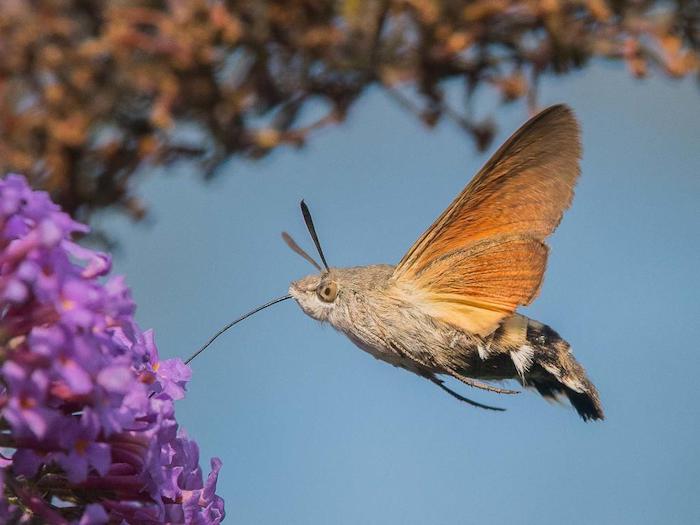
Humming-bird Hawk-moth
Photo Credit – Graeham Mounteney, Butterfly Conservation
Hummingbirds are small, often migratory birds that inhabit the Americas. They have compact bodies, long, narrow beaks, and relatively long blade-like wings. The latter allows them to fly in every direction and to hover. Typically, they migrate alone and travel up to 500 miles a day. The people of California benefit from the beauty, courage, and entertainment of hummingbirds in California.
The weight of hummingbirds is typically less than two pennies and the noise their wings make gives them their name. Distribution of this family is limited to the American continents, with approximately 350 species, including 15 in the United States and Canada. If you see one in Europe, it is likely that you either observe an escaped cage bird or a Hummingbird Hawk-moth, an insect that looks like a hummingbird when feeding. The moth’s range is Asia, North Africa, and Southern Europe. Let’s start with hummingbirds generally and finish with California’s hummingbirds.
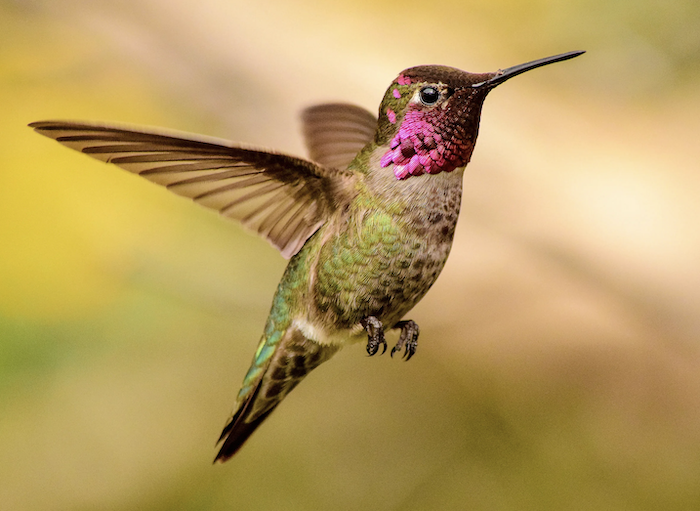 Anna’s Hummingbird (male)
Anna’s Hummingbird (male)
Photo Credit – National Audubon Society
First, the evolution of hummingbirds is a puzzle. The oldest hummingbird fossils are not in the Americas but in Germany, Poland, and France, and date back 30 plus million years. Today, these birds are extinct. Did they die out because of competition for food or because of an increasingly cold climate in Europe that persuaded them to move across the land bridge between Siberia and Alaska? From here, they could have colonized southwards and developed a diverse and rapidly expanding population. Alternatively, could there have been a natural convergence of evolution and the New World species developed independently? It is probable that we will never know.
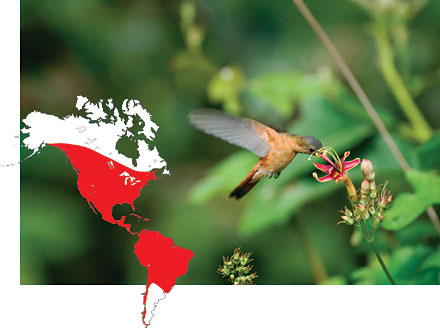
Hummingbirds Range
Photo Credit – Erik Stokstad, Science
Hummingbirds feed on nectar (occasionally insects) and consume up to 160 per cent of their body mass daily. They have a bias for red flowers and red feeders. This is in part due to the rich source of food, and partly because they possess trichromatic visual senses that prefer the range yellow to red and mute other colors such as blue. However, the main attraction is the quality of nectar, and it does not need to be colored! There is no need for you to add red food dye to the water you place in the hummingbird feeder. These birds are highly territorial and will fight to protect their mate, source of food, and their nest. This includes attacking bees, butterflies, and moths. I have even seen a hummingbird chase a raptor, presumably because it came too close to the hummingbird’s nest.
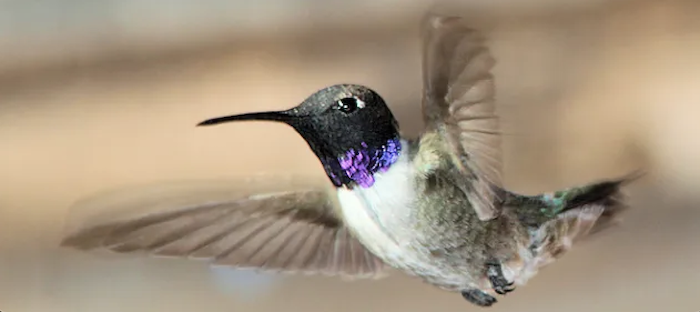
Black-chinned Hummingbird (male)
Photo Credit – Be Your Own Birder
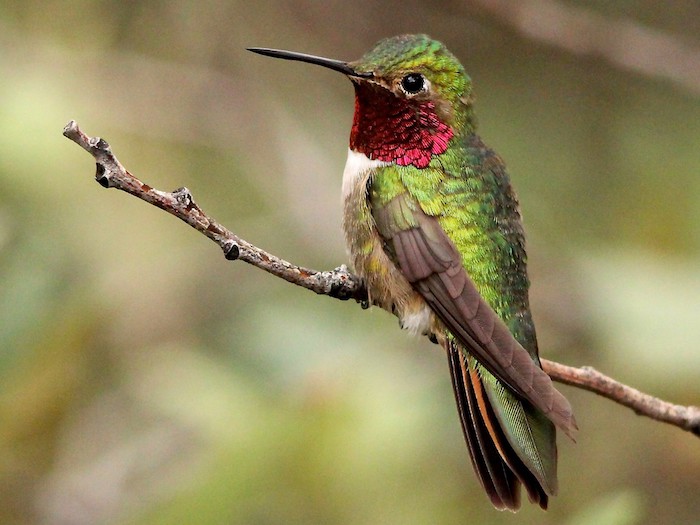
Broad-tailed Hummingbird (male)
Photo Credit – eBird
There are seven hummingbird species present in California. Only three appear regularly in my part of California, north of San Francisco, so I must travel to see the other four. Because hummingbirds are small and fast, it is difficult to distinguish one species from another. The four requiring that I travel are as follows:
- Black-chinned Hummingbirds – small, slender birds that, while uncommon, are broadly spread across the state except in my area north of San Francisco. A medium to long-distance migrant, these hummingbirds arrive during April/May and depart for western Mexico and southern Texas during July/August. A few remain residents year-round in southern California. Males are distinguished by a black head, metallic-green body, white breast, and an iridescent violet lower throat. Females are less dramatically colored.&nsbp;
- Broad-tailed Hummingbirds – these are medium-sized hummingbirds found only in the northwest of California and are present from late May to early August. They are common in the high-altitude areas of the Sierra Nevada, although their numbers have recently declined due to the destruction of their open space breeding habitat. They are migrants that winter in southern Mexico and Guatemala. Males are distinguished by an iridescent green back, on their throat a bright rose-red gorget (named after neck clothing and armor worn by men and women from the medieval times onwards), and white eye rings.
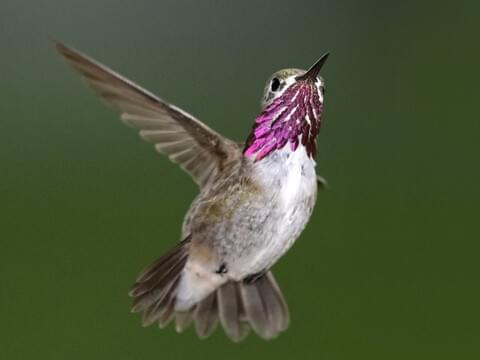
Calliope Hummingbird (male)Photo Credit – Cornell Lab of Ornithology
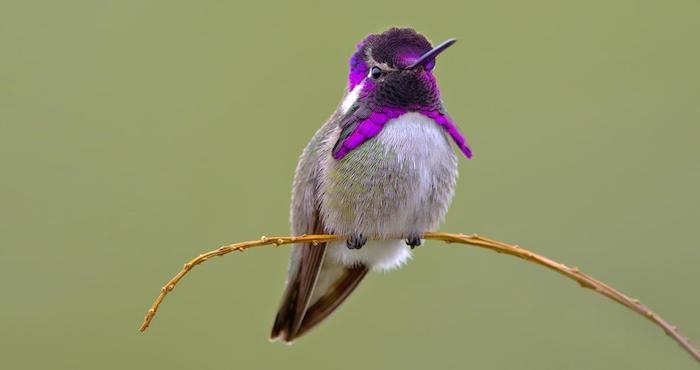
Costa’s Hummingbird (male)Photo Credit – Cornell Lab of Ornithology
- Calliope Hummingbirds – these are long distance migrants that pass along California’s Pacific coast on their way between Mexico and their breeding grounds in the northwest. During fall, they return south but use a route along the Rockies and Sierras. They are tiny, under four inches in length, and the smallest birds in California. Males are distinguished by a long, magenta-colored throat with similar colored feathers organized in streaks passing down the neck; the head and upper parts are metallic green, and the breast is white. They are named after Calliope, a Muse in Greek mythology, who inspired Homer’s Iliad and Odyssey.
- Costa’s Hummingbirds – are smallish, medium-distance migrants that winter in Mexico, and some remain resident year-round in southern California. They are common in the Mohave Desert and nearby gardens, and in the sage scrub of coastal California as far north as Santa Maria. Males are distinguished by a large, iridescent purple gorget that covers their head and flares along the sides of their neck. They are named after Louis Marie Pantaleon Costa de Beauregard, a 19th-century Sardinian nationalist who was fond of collecting hummingbirds.Now let me turn to the three species I am most familiar with because they appear in my neighborhood, starting with Anna’s Hummingbirds; these are by far the most common species of hummingbird in my part of northern California.
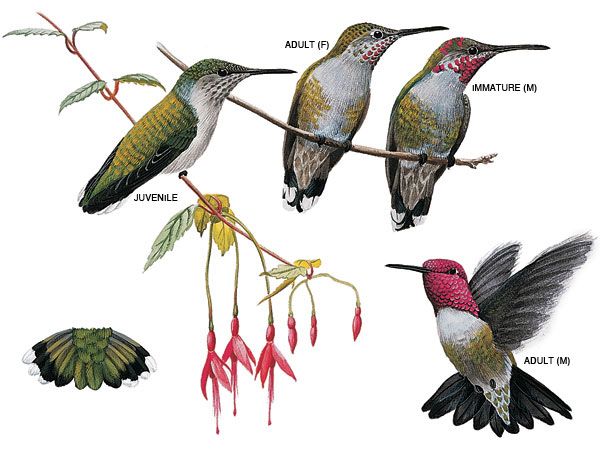
Anna’s HummingbirdsPhoto Credit – National Geographic
-
Anna’s Hummingbirds – These medium-sized, stocky, flashy, feisty, and fearless birds are named after Anne d’Essling, the wife of the Duke of Rivoli. She never likely saw one. The French naturalist René Primevère Lesson gave the name to the bird after observing the species in California, presumably to sponsor favor with the Italian family.
Anna’s Hummingbirds are common along the western coast of North America from northern Baja to southern Canada and many are permanent residents within this range. Their distribution explains why I have so many that visit my bird feeders year-round. Eight million Anna’s Hummingbirds are estimated to live in the western United States, and their numbers represent a substantial increase over the early 1970s. As temperatures warm, the territory for Anna’s Hummingbirds has expanded into the mountains of California, allowing their numbers to increase. Males are distinguished by a reddish-pink throat and reddish crown, an iridescent bronze-green back, pale grey belly, green flanks, and a slightly forked tail.
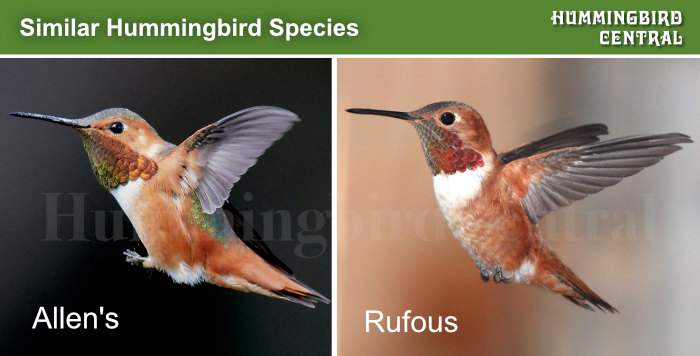
Allen’s and Rufous HummingbirdsPhoto Credit – Hummingbird Central
-
Allen’s Hummingbirds – small, compact, aggressive, territorial birds, and relatively rare. They migrate north beginning as early as December, and occupy a narrow strip of coastal forest, meadows, and gardens from Santa Barbara to southern Oregon. Their journey back to central Mexico takes place inland from June to August, although the birds that live around Los Angeles are often year-round residents. The species name celebrates Charles Andrew Allen, an American collector and taxidermist who identified the bird in 1879 in Nicasio, California. The species population has fallen by around 80 percent since 1968 to around 1.5 million. They are hard to distinguish from Rufous Hummingbirds. Males are identified from their green back and forehead, rust-colored flanks, rump, and tail, and iridescent orange-red throat. Females and immature adults are virtually identical in appearance to their equivalent Rufous Hummingbirds.
-
Rufous Hummingbirds – small, aggressive birds that pass through California (February to April and July to early October) on their nearly 4000-mile journey from Mexico, to breed north of California, as far north as Alaska, and then return home for winter. The population has declined significantly during the past 50 years but is large enough that these migrants remain familiar across California. Males are distinguished by their copper-orange back (although some are partially green, confusing their identity with Allen’s Hummingbirds). Their throat is an iridescent reddish-orange; they have a white breast and a white patch behind their eyes.
And finally:
Which are the smallest hummingbirds? The Bee Hummingbird, the smallest bird in the world, is found only in Cuba. It is two and a quarter inches long and weighs less than a dime.
Which are the largest hummingbirds? The Giant Hummingbird is nine inches in length and is found throughout the Andes on both the east and west sides.



